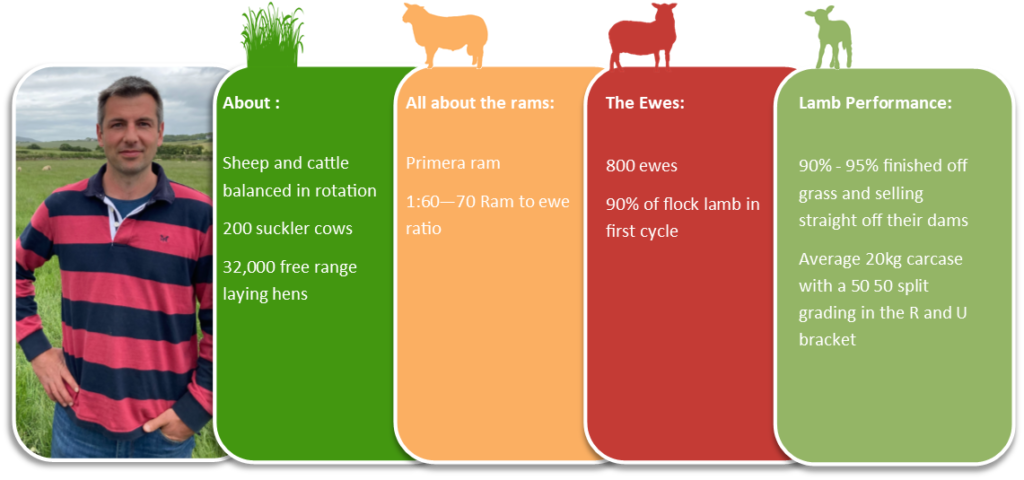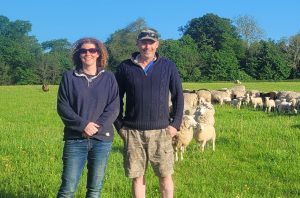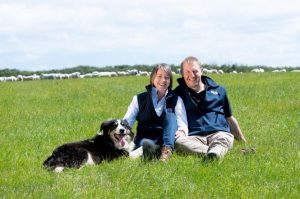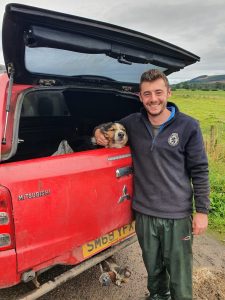with thanks to Harri Parri, Crugeran, Pwllheli

Efficiency for north Wales producer, Harri Parri is about maximising kilo per acre at minimal cost. “Big part of this is hitting KPIs so there’s no room for any passengers,” he says with his successful strategy featuring 90% to 95% of the unit’s Primera sired lambs finishing off grass and selling straight off their dams at 12 to 16 weeks by mid-May at the latest.
“Instead of selling lambs at a certain weight we sell on a certain date, however with growth rates averaging 0.40kg DLWG, the vast majority have reached an average 20kg carcase with a 50 50 split grading in the R and U bracket,” he explains. The entire crop are gone by end of June solely off grazed grass.
“We have introduced a system that works on what is a dry farm based near Pwhelli with an annual average 38” rainfall and two thirds of the farm free draining. We balance sheep and cattle in the rotation, and have to close the silage fields by mid-May or else we struggle to get sufficient yield.
“We could throw a lot of money at purchased concentrate and keep a higher stocking rate, but this would lead us to be under too much grazing pressure at other times of the year. One way of optimising efficiency for us is to control risk and we attempt to do that by depending on quality grazing crucial for early lamb finishing, along with homegrown forage and spring crops which provide a break for a five to seven year grass reseeding programme featuring high sugar varieties and white clover. As the season progresses, we have space for flushing and ram mating,” he says. “And taking a whole business approach, cattle and hens provide huge fertility to the land allowing us to minimise other variables, for example, fertiliser is restricted to buying in minimal nitrogen.”
Harri swapped Continental rams for the Primera meat sire four years ago. “Our lambs weren’t getting quite heavy enough by mid-May and we considered there were various other breeds that could do a better job. The Primera suited us since it is forage bred and reared and whilst we are losing half a grade, that’s more than made up by the fact we are gaining at least a kilo from each lamb on carcase weight. And that additional weight to me this year is worth around £6.50 to £7/kg, a great deal more than 10p to 15p/kg for an extra grade on a 20kg carcase.”
Lambing has fast forward by an average five days since the Primera was introduced, a trend Harri attributes to the fact the rams are maturing earlier, they start to cycle earlier in the season and they’re keener to work. Combine with Lleyn cross New Zealand Suffolk ewes – Harri’s chosen damline for their ability to start cycling in early August, together with longevity, and an average 90% of the flock lambs within the first cycle. “Since introducing the Primera, lambing seems easier and the lambs appear to be more vigorous, quicker to suck and subsequently more resilient,” he says.
And whilst he admits the Primera ram to ewe ratio could be higher, at 1:60 to 70 ewes, it’s another risk avoidance tactic and the ratio has been extended from a previous 1:50. We need to get those ewes inlamb and quickly, i prefer to carry an extra ram through the year.
The flock lambs indoors and is turned out after 48 hours on to 2,300kg to 2,800kg DM/ha covers which Harri refers to as the best quality grazing having been shut up for 60 to 90 days, and set stocked at three ewes per acre. “Throughout February and March, the ewe’s demand for energy and protein exceeds grass growth, and instead of purchased concentrate, we strip graze fodder beet.”
Harri explains the fodder beet is strategically planted around the grazing platform, for example in five-acre field corners so that ewes and lambs access the crop from various fields. Depending on the season, but as magic day arrives when grass growth exceeds demand – usually mid March, stocking rate increases to five to six ewes per acre. “Lambs go on to finish on our second-best grazing combined with April/May sunshine on their backs, they’re flying.”



